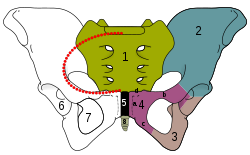Pubic symphysis
| Pubic symphysis | |
|---|---|

Symphysis pubis exposed by a coronal section. (Pubic symphysis visible at center left.)
|
|

#5 is Pubic symphysis
|
|
| Details | |
| Identifiers | |
| Latin | symphysis pubica, symphysis pubis |
| TA | A03.6.02.001 |
| FMA | 16950 |
|
Anatomical terminology
[]
|
|
The pubic symphysis or symphysis pubis is the midline cartilaginous joint (secondary cartilaginous) uniting the superior rami of the left and right pubic bones. It is located anterior to the urinary bladder and superior to it. In males, the suspensory ligament of the penis attaches to the pubic symphysis. In females, the pubic symphysis is intimately close to the clitoris. In normal adults it can be moved roughly 2 mm and with 1 degree rotation. This increases for women at the time of childbirth.
The pubic symphysis is a nonsynovial amphiarthrodial joint. The name comes from the Greek word "symphysis", meaning "growing together". The width of the pubic symphysis at the front is 3–5 mm greater than its width at the back. This joint is connected by fibrocartilage and may contain a fluid-filled cavity; the center is avascular, possibly due to the nature of the compressive forces passing through this joint, which may lead to harmful vascular disease. The ends of both pubic bones are covered by a thin layer of hyaline cartilage attached to the fibrocartilage. The fibrocartilaginous disk is reinforced by a series of ligaments. These ligaments cling to the fibrocartilaginous disk to the point that fibers intermix with it.
Two such ligaments are the superior pubic ligament and the inferior pubic ligament, which provide the most stability; the anterior and posterior ligaments are weaker. The strong and thicker superior ligament is reinforced by the tendons of the rectus abdominis muscle, the abdominal external oblique muscle, the gracilis muscle, and by muscles of the hip. The superior pubic ligament connects together the two pubic bones superiorly, extending laterally as far as the pubic tubercles. The inferior ligament in the pubic arch is also known as the arcuate pubic ligament or subpubic ligament; it is a thick, triangular arch of ligamentous fibers, connecting together the two pubic bones below, and forming the upper boundary of the pubic arch. Above, it is blended with the interpubic fibrocartilaginous lamina; laterally, it is attached to the inferior rami of the pubic bones; below, it is free, and is separated from the fascia of the urogenital diaphragm by an opening through which the deep dorsal vein of the penis passes into the pelvis.
...
Wikipedia
